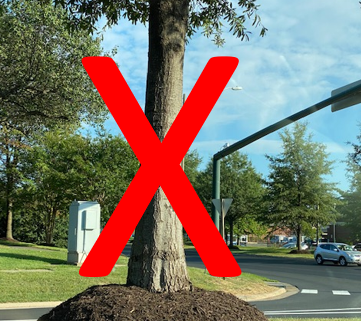The Tree Trimming Scammers
Article by Cindy Speas, Chair of the Fairfax County Tree Commission
Photo: fairfaxcounty.gov
The doorbell rings, and at your door is a young man who says, “Hello, I was driving by and noticed your trees need some pruning. I’ve been working at your neighbor’s house, and thought I’d stop and offer you the same deal!”
It must be spring. We often hear about telephone or online financial scams, but what about the “woodchucks” or tree scammers that arrive at your door? These are seasonal workers, usually untrained, uncertified, and unlicensed. Beware! They come bearing disaster for our trees, as well as our wallets.
Last spring Fairfax County posted a great article about the tree trimming scam. One police officer is quoted as saying this is “one of the most pervasive criminal problems this county is facing right now.” It happens in all seasons, of course, when trucks drive by looking for accessibility ramps or seniors working in their yards, or in spring seeking “unkempt” yards. So, if you have a yard full of native plants and little lawn, and you wait for just the right time after winter to clean up your beds, you could be a target.
These folks are not arborists and may remove living wood or, at worst, “top” your healthy tree. When the growing end of every tree limb or branch is lopped off, the tree can lose as much as 75% of its leaves, which provide a majority of the tree’s food. When a tree is weakened by less food and water, it becomes vulnerable to insect, sun and wind damage. These stresses mean that the tree may not survive the butchering. When you see a lot of fast growing shoots where major limbs were cut, that is a major sign of stress and poor health. Many municipalities and counties have great resources for resisting this fraudulent behavior. Here’s one from Fairfax County: https://www.fairfaxcounty.gov/publicworks/trees/plant-care. It’s one thing to spend—or even overspend—on taking out a dead limb, but quite another to fall for the “just let us prune your trees and everything will be fine” pitch. And don’t forget, untrained workers may use spikes on their boots because they are not taught the best practices of a reputable tree care specialist. This is highly damaging to the health of your trees.
Our trees are critical to our quality of life, and to the economic value of our homes, but they are threatened by “woodchucks.” Become informed about tree care—a good arborist can be as valuable to the life of your tree as a good electrician or plumber is to the life of your home. It is worth taking the time to find out if these solicitors are licensed and insured, certified in their area of expertise, and have good recommendations. Compare and weigh the costs and benefits of particular work that you know you need—don’t take the cheapest and easiest course of action. Be a good consumer and do the research. Just say NO to the door-to-door solicitor and yes only to the company YOU call that has good reviews, an arborist on staff, and free initial consultations.
Beware! Your beautiful trees are counting on you to speak for them and protect them.



